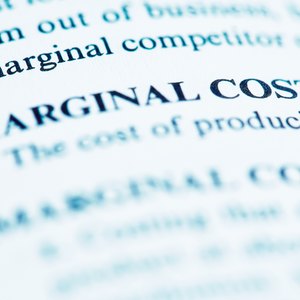
The marginal cost of production is horizontal, or constant, when it equals the average total cost of production. When the marginal cost curve is a straight line, the additional cost to produce an additional unit of output remains constant for every unit produced. Whatever the number of units produced, the marginal cost remains the same. Marginal cost is directly related to production level, pricing and profit.
What Is Marginal Cost?
Economists use concepts like marginal cost in microeconomics to analyze and explain the decisions and behavior of consumers and companies/firms and the influence of markets.
According to microeconomics, a firm’s marginal cost, or marginal cost of production, refers to “one more." Therefore, Penn State explains that marginal cost is the cost of producing one additional unit. In business, marginal cost is often compared next to marginal revenue. In other words, if a company’s team is deciding whether they should make one more of something, they will also want to know how much they stand to gain from producing that one additional unit.
Marginal cost is used to help a company or organization determine the optimal level of production to maximize profits and reach a stable unit price. Marginal costs are considered in all types of business from manufacturing and production to healthcare and government.
Short-Run vs. Long-Run Marginal Cost
Short-run marginal cost is the short-term cost of increasing by one production unit with a company’s current assets, notes Oregon State University. Long-run marginal cost refers to the increased marginal cost of scaling other variable costs along with business expansion.
How Is Marginal Cost Calculated?
To calculate marginal cost, you need to know how much your cost-of-production cost changed when the additional unit was produced. If you have had a second production run with more than one unit, you would take the total cost increase between the first and second run and divide it by the number of items in the new run to learn the cost of one additional unit.
Marginal cost = Change in total cost of production / Change in quantity of output
Fixed Costs vs. Variable Costs
Fixed costs typically do not affect the marginal cost of production because they stay the same no matter how many units are produced. When divided by total units, the average fixed cost decreases as the production level increases.
It is the variable costs that change along with levels of production. Supplies, raw materials, labor, utilities, transportation and other costs that change as additional units are produced are the variable costs that affect marginal cost.
The average variable cost starts high but tends to flatten out as the production level increases due to economies of scale. As production scales up, a producer can buy in bulk or use buying power to receive discounts. Economies of scale don’t last forever, however. As quantity increases, variable costs can begin to rise again.
Marginal Cost vs. Average Total Cost
Marginal cost (MC) is the cost for the last additional unit produced, whereas average total cost (ATC) is the total cost of all items produced divided by the total number of units produced.
In general, average cost tends to be more than marginal cost in the short term since average cost considers fixed costs. Over time as total output increases, the total cost of production increases. As the number of units increases, average total cost will decrease.
What Is the Law of Diminishing Returns?
While producing additional units leads to a higher output level in the short-run, the microeconomic theory of diminishing returns states that the production level will plateau and marginal returns will start to decrease.
What Is Marginal Cost Curve?
The marginal cost curve is the graphed representation of the change in marginal cost over time. If a company is producing goods, this may also be called the supply curve. Typically, marginal cost appears as a U-shaped line, indicating the higher initial marginal cost, the steep drop in cost as production increases and then the rise as the law of diminishing returns sets in.
Constant marginal cost, or horizontal marginal cost, is represented by a flat line, indicating that the unit cost of production has now reached a constant.
In comparison, the average variable cost (AVC) and average total cost (ATC) curves start much higher than marginal cost, drop steeply as production levels increase and then begin to rise again as levels of production scale up.
Is Horizontal Marginal Cost a Good Thing?
In a competitive market, the goal of tracking marginal cost is to help a company assess the demand curve and determine the optimal production volume and profit maximization of a product. When marginal cost and average total cost are equal, the additional cost of another unit has flattened out. A company will profit if market demand allows the product to sell above that constant marginal cost.
In addition to marginal cost, a company will consider other microeconomic factors when determining pricing and level of production. For example, it will consider marginal revenue, and as Iowa State University explains, the elasticity of demand also comes into play.
References
Writer Bio
Melissa is a writer and editor from Chicago, with a background in small business ownership. After selling her business, she moved into marketing for nonprofits and now manages volunteers at a large medical association. She is a writing and editing contractor and contributed to dozens of blogs and websites.

